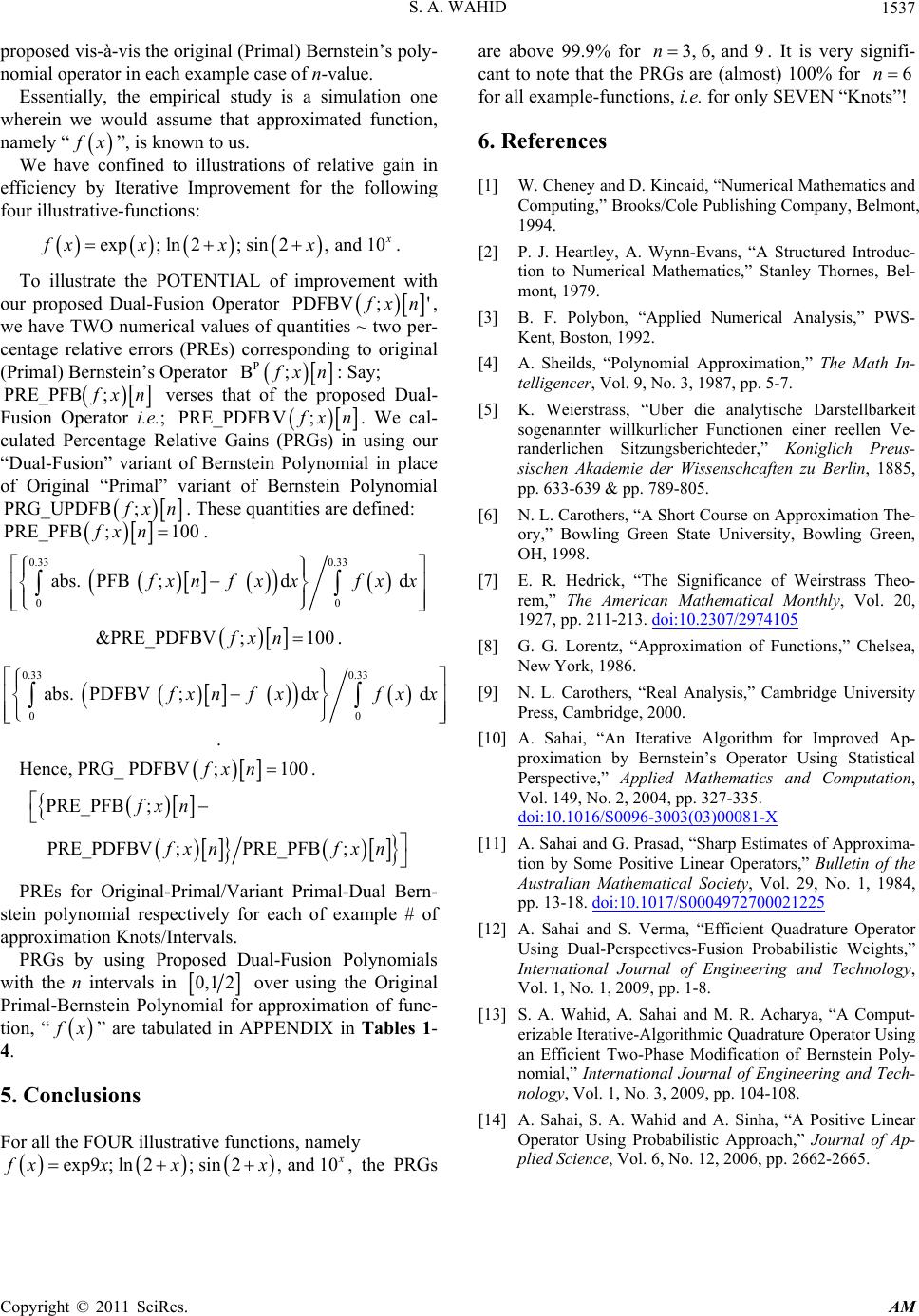
S. A. WAHID
Copyright © 2011 SciRes. AM
1537
proposed vis-à-vis the original (Primal) Bernstein’s poly-
nomial operator in each example case of n-value.
Essentially, the empirical study is a simulation one
wherein we would assume that approximated function,
namely “
x”, is known to us.
We have confined to illustrations of relative gain in
efficiency by Iterative Improvement for the following
four illustrative-functions:
exp; ln2; sin2,and 10
fx xxx.
To illustrate the POTENTIAL of improvement with
our proposed Dual-Fusion Operator
PDFBV ;'
xn
,
we have TWO numerical values of quantities ~ two per-
centage relative errors (PREs) corresponding to original
(Primal) Bernstein’s Operator
P
B;
xn: Say;
PRE_PFB ;
xn verses that of the proposed Dual-
Fusion Operator i.e.;
PRE_PDFB V;
xn. We cal-
culated Percentage Relative Gains (PRGs) in using our
“Dual-Fusion” variant of Bernstein Polynomial in place
of Original “Primal” variant of Bernstein Polynomial
PRG_UPDFB ;
x
n. These quantities are defined:
PRE_PFB;fxn100.
0.33 0.33
0
abs. PFB ; d d
0
xnf xxfxx
&PRE_PDFBV
;1fx n00.
0.33 0.33
0
abs. PDFBV ; d d
0
xnf xxfxx
.
Hence, PRG_ PDFBV
; 100fxn.
PRE_PFB;
PRE_PDFBV ;PRE_PFB ;
fx n
xn fxn
PREs for Original-Primal/Variant Primal-Dual Bern-
stein polynomial respectively for each of example # of
approximation Knots/Intervals.
PRGs by using Proposed Dual-Fusion Polynomials
with the n intervals in
0,1 2 over using the Original
Primal-Bernstein Polynomial for approximation of func-
tion, “
x” are tabulated in APPENDIX in Tables 1-
4.
5. Conclusions
For all the FOUR illustrative functions, namely
exp9; ln2; sin2,and 10
fxx xx, the PRGs
are above 99.9% for 3, 6,and9n
. It is very signifi-
cant to note that the PRGs are (almost) 100% for 6n
for all example-functions, i.e. for only SEVEN “Knots”!
6. References
[1] W. Cheney and D. Kincaid, “Numerical Mathematics and
Computing,” Brooks/Cole Publishing Company, Belmont,
1994.
[2] P. J. Heartley, A. Wynn-Evans, “A Structured Introduc-
tion to Numerical Mathematics,” Stanley Thornes, Bel-
mont, 1979.
[3] B. F. Polybon, “Applied Numerical Analysis,” PWS-
Kent, Boston, 1992.
[4] A. Sheilds, “Polynomial Approximation,” The Math In-
telligencer, Vol. 9, No. 3, 1987, pp. 5-7.
[5] K. Weierstrass, “Uber die analytische Darstellbarkeit
sogenannter willkurlicher Functionen einer reellen Ve-
randerlichen Sitzungsberichteder,” Koniglich Preus-
sischen Akademie der Wissenschcaften zu Berlin, 1885,
pp. 633-639 & pp. 789-805.
[6] N. L. Carothers, “A Short Course on Approximation The-
ory,” Bowling Green State University, Bowling Green,
OH, 1998.
[7] E. R. Hedrick, “The Significance of Weirstrass Theo-
rem,” The American Mathematical Monthly, Vol. 20,
1927, pp. 211-213. doi:10.2307/2974105
[8] G. G. Lorentz, “Approximation of Functions,” Chelsea,
New York, 1986.
[9] N. L. Carothers, “Real Analysis,” Cambridge University
Press, Cambridge, 2000.
[10] A. Sahai, “An Iterative Algorithm for Improved Ap-
proximation by Bernstein’s Operator Using Statistical
Perspective,” Applied Mathematics and Computation,
Vol. 149, No. 2, 2004, pp. 327-335.
doi:10.1016/S0096-3003(03)00081-X
[11] A. Sahai and G. Prasad, “Sharp Estimates of Approxima-
tion by Some Positive Linear Operators,” Bulletin of the
Australian Mathematical Society, Vol. 29, No. 1, 1984,
pp. 13-18. doi:10.1017/S0004972700021225
[12] A. Sahai and S. Verma, “Efficient Quadrature Operator
Using Dual-Perspectives-Fusion Probabilistic Weights,”
International Journal of Engineering and Technology,
Vol. 1, No. 1, 2009, pp. 1-8.
[13] S. A. Wahid, A. Sahai and M. R. Acharya, “A Comput-
erizable Iterative-Algorithmic Quadrature Operator Using
an Efficient Two-Phase Modification of Bernstein Poly-
nomial,” International Journal of Engineering and Tech-
nology, Vol. 1, No. 3, 2009, pp. 104-108.
[14] A. Sahai, S. A. Wahid and A. Sinha, “A Positive Linear
Operator Using Probabilistic Approach,” Journal of Ap-
plied Science, Vol. 6, No. 12, 2006, pp. 2662-2665.